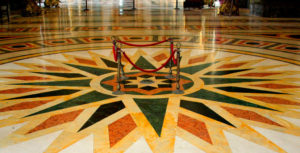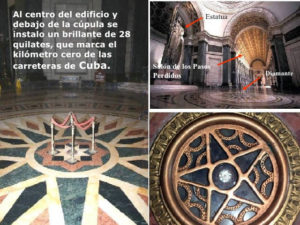HISTORY OF THE LUXURIOUS DIAMOND PLANTED IN THE FLOOR OF THE CUBAN CAPITOL
During the government of Gerardo Machado, General of the War of Independence, the construction of the Capitol of Havana, the Central Highway, and other works, as well as important economic achievements, stand out. His mandate was characterized by the economic boom, but also by the repression of the opposition forces.
To satisfy the excessive national vanity of the young Republic, it was decided to acquire a diamond, planted on the main floor of the emblematic Capitol, where it would mark the zero kilometers of the Cuban highway network, in particular the Central Highway. Surrounded by legend, it is said that the jewel belonged to a Russian czar and that it came to Cuba from the hand of a Turkish jeweler who acquired it in France. What we know for sure is that it was bought by the government of General Gerardo Machado.
https://youtu.be/mdGRgFVAz_Y
THE CAPITOL DIAMOND STORY (VIDEOS)
The Romans measured their distances from a landmark located on the Capitol. The French, from the famous Parisian Arc de Triomphe, and in the US the eastern road system starts from the needle of the Capitol in Washington. Cuba could not be less.
Isaac Estéfano, a jeweler based in Havana and who did good business here with jewels from the Russian aristocracy, managed to interest María Jaén, wife of President Alfredo Zayas, in one of the five diamonds that made up one of the crowns of the last Tsar of Russia, Nicholas II.
Carlos Miguel de Céspedes, Minister of Public Works of the Machado government, was interested in acquiring it to place it in the Capitol, still under construction. At that point, the jeweler was satisfied with 12,000 pesos. Workers, technicians, engineers and architects who participated in the construction of the majestic work and even the contracting firm itself contributed 9,000 pesos. The remaining 3,000 were put by Carlos Miguel from his pocket.
The jewel was considered one of the best-protected treasures of the Republic. They had set it in agate and platinum before inserting it into a block of andesite, the strongest granite in the world, and this, in turn, was covered by another, concrete, as it was embedded in the floor, in the center of the Hall. A cut crystal, so solid that it was considered unbreakable, reinforced its protection.
THEFT OF THE DIAMOND FROM THE CUBAN CAPITOL
When the Capitol was inaugurated on May 20, 1929, the brilliant was already in place and due to its sumptuous setting, the carving and its surprising yellow glow, it was the center of attention of the national personalities and foreign dignitaries who attended that day. the inauguration of President Machado determined to extend himself in power against the opinion of the most responsible sectors of the country. And when the building was transferred to the Congress of the Republic, the jewel continued to be the highest point of attraction for visitors from Cuba and other countries.
A few minutes in the morning of March 25, 1946, the thieves were enough to steal the diamond. Months passed and the theft of the diamond seemed to have fallen into the category of perfect crimes, when, on June 2, 1947, president Grau, 15 months after its loss, said that the diamond was inside a small, worn yellow envelope and that it had been sent to him anonymously.
The theories were outlined by the hundreds, but like many other criminal acts that occurred in the period of the authentic governments (1944-1952), the theft of the brilliant from the Capitol remained unclear. The era of gangsterism in Cuba reached the Capitol.
In 1973, the diamond was replaced by a replica for security reasons and it was kept in the safe deposit box of the Central Bank of Cuba, but like all things of the revolutionary government, there is no clarity about the destination of the diamond, of which no there is some evidence.
No one knows if the great 25-carat diamond at the foot of the Statue of the Republic and under the dome that stands 92 meters high, marked the Zero Kilometer of that other icon of the Cuban civil engineering that was the Central Highway.
As has happened with many things in Cuba, it is possible that it is in the Kremlin or in a secret vault in a Swiss bank, belonging and you know who.
HISTORIA DEL SUNTUOSO DIAMANTE SEMBRADO EN EL PISO DEL CAPITOLIO CUBANO
Durante el gobierno de Gerardo Machado, General de la Guerra de Independencia, destacan la construcción del Capitolio de La Habana, la Carretera Central y otras obras, así como importantes logros económicos. Su mandato se caracterizó por la bonanza económica, pero también por la represión de las fuerzas opositoras.
Para satisfacer la desmedida vanidad nacional de la joven República, se decidió adquirir un diamante, sembrado en el piso principal del emblemático Capitolio, donde marcaría el kilómetro cero de la red de carreteras cubanas, en particular la Carretera Central. Rodeada de leyenda, se dice que la joya perteneció a un zar ruso, y que llegó a Cuba de la mano de un joyero turco que la adquirió en Francia. Lo que sabemos con certeza es que fue comprada por el gobierno del General Gerardo Machado.
Los romanos medían sus distancias a partir de un hito situado en el Capitolio. Los franceses, desde el célebre Arco de Triunfo parisino, y en los EE.UU. el sistema vial del Este arranca desde la aguja del Capitolio de Washington. Cuba no podía ser menos.
https://youtu.be/JnpVLHlRZCs
EL ROBO DEL DIAMANTE DEL CAPITOLIO CUBANO (VIDEOS)
Isaac Estéfano, un joyero radicado en La Habana y que hizo aquí buenos negocios con joyas de la aristocracia rusa, logró interesar a María Jaén, esposa del presidente Alfredo Zayas, en uno de los cinco brillantes que conformaban una de las coronas del último zar de Rusia, Nicolás II.
Carlos Miguel de Céspedes, ministro de Obras Públicas del gobierno de Machado, se interesó en adquirirla para colocarla en el Capitolio, todavía en construcción. A esa altura el joyero se conformaba con 12 000 pesos. Obreros, técnicos, ingenieros y arquitectos que participaban en la edificación de la majestuosa obra y hasta la misma firma contratista aportaron 9 000 pesos. Los 3 000 restantes los puso Carlos Miguel de su bolsillo.
La joya se consideraba uno de los tesoros mejor protegidos de la República. La habían engarzado en ágata y platino antes de introducirla en un bloque de andesita, el granito más fuerte del mundo, y este a su vez fue recubierto por otro, de concreto, al empotrarse en el piso, en el centro del Salón. Un cristal tallado, tan sólido que se estimaba irrompible, reforzaba su resguardo.
ROBO DEL DIAMANTE DEL CAPITOLIO CUBANO
Al inaugurarse el Capitolio el 20 de mayo de 1929, el brillante estaba ya en su sitio y por su engarce suntuoso, el tallado y su sorprendente fulgor amarillo fue el centro de la atención de las personalidades nacionales y los dignatarios extranjeros que ese día asistieron a la toma de posesión del presidente Machado, empeñado en prorrogarse en el poder en contra de la opinión de los sectores más responsables del país. Y cuando se traspasó el edificio al Congreso de la República, la joya continuó siendo el punto máximo de atracción de los visitantes cubanos y de otros países.
Pocos minutos de la madrugada del 25 de marzo de 1946 bastaron a los ladrones para sustraer el brillante, Pasaron los meses y el robo del brillante parecía haber caído en la categoría de los crímenes perfectos, cuando, el 2 de junio del 1947, el presidente Grau, 15 meses después de su pérdida, dijo que el brillante estaba dentro de un pequeño y ajado sobre amarillo y que le había sido enviado de forma anónima.
Las teorías se esbozaron por cientos, pero como otros muchos hechos delictivos ocurridos en el período de los gobiernos auténticos (1944-1952), el robo del brillante del Capitolio quedó sin esclarecer. La era del gangsterismo en Cuba llegó hasta el Capitolio.
En 1973 se sustituyó el diamante por una réplica por cuestiones de seguridad y se guardó en la caja de seguridad del Banco Central de Cuba, pero como todas las cosas del gobierno revolucionario, no existe claridad alguna sobre el destino del diamante, de lo cual no existen pruebas algunas.
Nadie sabe si se volverá a colocar en su lugar original el gran diamante de 25 quilates que a los pies de la Estatua de la República y bajo la cúpula que se yergue a 92 metros de altura, marcaba el Kilómetro Cero de ese otro ícono de la ingeniería civil cubana que fue la Carretera Central.
Como ha ocurrido con muchas cosas en Cuba, es posible que se encuentre en el Kremlim o en una bóveda secreta en un banco suizo, perteneciente ya ustedes saben a quién.
Agencies/ MemoriasCubanas/ Carlos RodriguezB. / Internet Photos/ YouTube/ Arnoldo Varona/ www.TheCubanHistory.com
THE CUBAN HISTORY, HOLLYWOOD.



 HISTORY of the Luxirious Diamond Planted in the Floor of the Cuban Capitolio. * HISTORIA del Lujoso Diamante plantado en el Piso del Capitolio Cubano. PHOTOS.
HISTORY of the Luxirious Diamond Planted in the Floor of the Cuban Capitolio. * HISTORIA del Lujoso Diamante plantado en el Piso del Capitolio Cubano. PHOTOS.






